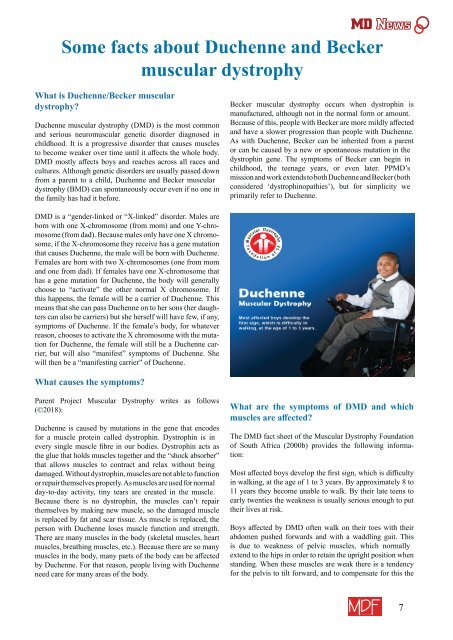MDF Magazine Newsletter Issue 57 December 2018
Create successful ePaper yourself
Turn your PDF publications into a flip-book with our unique Google optimized e-Paper software.
MD<br />
Some facts about Duchenne and Becker<br />
muscular dystrophy<br />
What is Duchenne/Becker muscular<br />
dystrophy?<br />
Duchenne muscular dystrophy (DMD) is the most common<br />
and serious neuromuscular genetic disorder diagnosed in<br />
childhood. It is a progressive disorder that causes muscles<br />
to become weaker over time until it affects the whole body.<br />
DMD mostly affects boys and reaches across all races and<br />
cultures. Although genetic disorders are usually passed down<br />
from a parent to a child, Duchenne and Becker muscular<br />
dystrophy (BMD) can spontaneously occur even if no one in<br />
the family has had it before.<br />
Becker muscular dystrophy occurs when dystrophin is<br />
manufactured, although not in the normal form or amount.<br />
Because of this, people with Becker are more mildly affected<br />
and have a slower progression than people with Duchenne.<br />
As with Duchenne, Becker can be inherited from a parent<br />
or can be caused by a new or spontaneous mutation in the<br />
dystrophin gene. The symptoms of Becker can begin in<br />
childhood, the teenage years, or even later. PPMD’s<br />
mission and work extends to both Duchenne and Becker (both<br />
considered ‘dystrophinopathies’), but for simplicity we<br />
primarily refer to Duchenne.<br />
DMD is a “gender-linked or “X-linked” disorder. Males are<br />
born with one X-chromosome (from mom) and one Y-chromosome<br />
(from dad). Because males only have one X chromosome,<br />
if the X-chromosome they receive has a gene mutation<br />
that causes Duchenne, the male will be born with Duchenne.<br />
Females are born with two X-chromosomes (one from mom<br />
and one from dad). If females have one X-chromosome that<br />
has a gene mutation for Duchenne, the body will generally<br />
choose to “activate” the other normal X chromosome. If<br />
this happens, the female will be a carrier of Duchenne. This<br />
means that she can pass Duchenne on to her sons (her daughters<br />
can also be carriers) but she herself will have few, if any,<br />
symptoms of Duchenne. If the female’s body, for whatever<br />
reason, chooses to activate the X chromosome with the mutation<br />
for Duchenne, the female will still be a Duchenne carrier,<br />
but will also “manifest” symptoms of Duchenne. She<br />
will then be a “manifesting carrier” of Duchenne.<br />
What causes the symptoms?<br />
Parent Project Muscular Dystrophy writes as follows<br />
(©<strong>2018</strong>):<br />
Duchenne is caused by mutations in the gene that encodes<br />
for a muscle protein called dystrophin. Dystrophin is in<br />
every single muscle fibre in our bodies. Dystrophin acts as<br />
the glue that holds muscles together and the “shock absorber”<br />
that allows muscles to contract and relax without being<br />
damaged. Without dystrophin, muscles are not able to function<br />
or repair themselves properly. As muscles are used for normal<br />
day-to-day activity, tiny tears are created in the muscle.<br />
Because there is no dystrophin, the muscles can’t repair<br />
themselves by making new muscle, so the damaged muscle<br />
is replaced by fat and scar tissue. As muscle is replaced, the<br />
person with Duchenne loses muscle function and strength.<br />
There are many muscles in the body (skeletal muscles, heart<br />
muscles, breathing muscles, etc.). Because there are so many<br />
muscles in the body, many parts of the body can be affected<br />
by Duchenne. For that reason, people living with Duchenne<br />
need care for many areas of the body.<br />
What are the symptoms of DMD and which<br />
muscles are affected?<br />
The DMD fact sheet of the Muscular Dystrophy Foundation<br />
of South Africa (2000b) provides the following information:<br />
Most affected boys develop the first sign, which is difficulty<br />
in walking, at the age of 1 to 3 years. By approximately 8 to<br />
11 years they become unable to walk. By their late teens to<br />
early twenties the weakness is usually serious enough to put<br />
their lives at risk.<br />
Boys affected by DMD often walk on their toes with their<br />
abdomen pushed forwards and with a waddling gait. This<br />
is due to weakness of pelvic muscles, which normally<br />
extend to the hips in order to retain the upright position when<br />
standing. When these muscles are weak there is a tendency<br />
for the pelvis to tilt forward, and to compensate for this the<br />
7


















